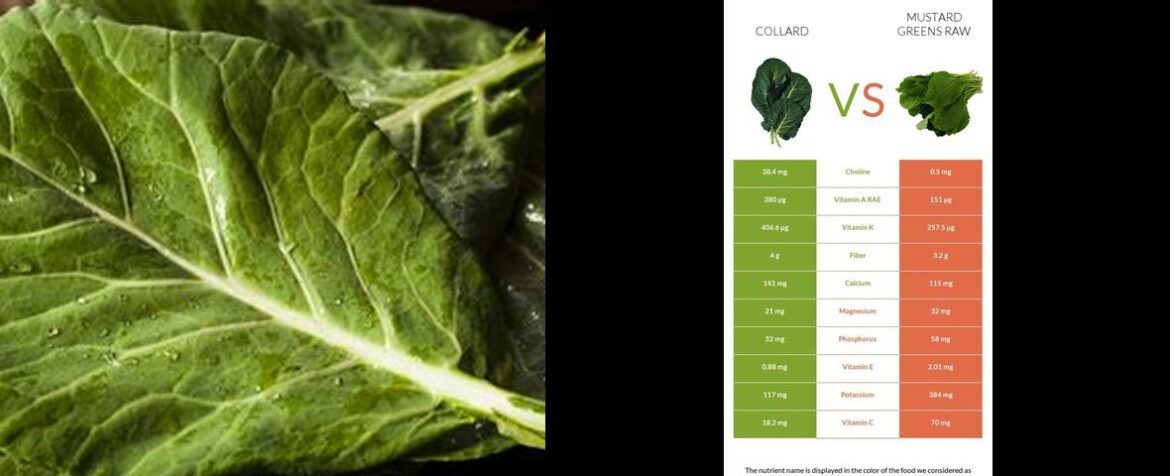Collard Greens Vs Mustard Greens – Collard Greens vs. Mustard Greens: Unveiling the Nuances of Two Leafy Delights
Are you ready to embark on a leafy adventure? Get ready to discover the delightful world of collard greens and mustard greens! These two vegetables may seem similar at first glance, but their subtle differences are what make them truly unique. So, buckle up and join us as we dive into the depths of these greens, unraveling their flavors, textures, and nutritional benefits. Whether you’re a die-hard fan of one or simply curious to explore the other, this guide will leave you craving for more. Get ready to take your taste buds on a journey and uncover the ultimate winner in the battle of collard greens vs. mustard greens.
Collard Greens vs. Mustard Greens: Unveiling the Nuances of Two Leafy Delights
In the vibrant tapestry of leafy greens, collard greens and mustard greens stand out as two prominent players, each possessing unique characteristics and culinary versatility. While often used interchangeably, these two leafy wonders offer distinct flavor profiles, nutritional compositions, and culinary applications that make them worthy of individual exploration. Embark on a culinary journey as we delve into the world of collard greens vs. mustard greens, unraveling their differences and similarities.
Delving into the Depths of Flavor: A Tale of Two Tastes
Collard greens, adorned with their broad, dark, green leaves, exude a mild, sweet flavor with a subtle hint of bitterness. Their texture, characterized by a satisfying chewiness, adds a delightful dimension to various dishes. Mustard greens, on the other hand, flaunt frilly, jagged-edged leaves that burst with a sharp, peppery tang. Their texture, more delicate than their collard counterparts, offers a delightful crunch with each bite.
A Nutritious Duet: Unveiling the Health Benefits
Beyond their culinary appeal, collard greens and mustard greens are nutritional powerhouses, brimming with an array of essential vitamins, minerals, and phytonutrients. Collard greens reign supreme in vitamin K, vitamin A, folate, and calcium, while mustard greens boast impressive levels of vitamin C, vitamin A, vitamin K, manganese, and potassium. Both greens are low in calories and rich in fiber, making them ideal for weight management and digestive health.
Culinary Symphony: Exploring Culinary Applications
Collard greens and mustard greens shine in a multitude of culinary creations, adding depth of flavor and nutritional value. Collard greens lend their mild sweetness to sautéed dishes, soups, stews, and stir-fries. Mustard greens, with their peppery tang, excel in salads, sandwiches, and as a blanched side dish. Both greens can be steamed, sautéed, or added to soups and stews, offering endless possibilities for culinary exploration.
Hoppin’ John and Beyond: A Culinary Journey
Collard greens and mustard greens have carved out their unique niches in culinary traditions worldwide. Collard greens take center stage in the beloved Southern dish Hoppin’ John, a hearty combination of black-eyed peas, rice, and collard greens, often served on New Year’s Day for good luck. Mustard greens, on the other hand, are a staple in Asian cuisine, frequently appearing in stir-fries, soups, and noodle dishes.
Selecting and Preparing: Ensuring Optimal Quality and Flavor
When selecting collard greens and mustard greens, opt for leaves that are vibrant in color, free of blemishes, and have a crisp texture. Thoroughly wash the greens before cooking, removing any tough stems or discolored leaves. Collard greens and mustard greens can be cooked using various methods, including boiling, sautéing, or steaming. Season the greens with your desired flavors, such as salt, pepper, garlic, or spices, and cook until tender but still retaining a slight bite.
Experimentation: Unlocking Culinary Treasures
The culinary journey of collard greens and mustard greens is far from exhaustive. Experiment with different cooking techniques and seasonings to discover your favorite ways to enjoy these nutritious greens. Try sautéing collard greens with garlic and olive oil for a simple yet flavorful side dish. Blanch mustard greens and serve them with a tangy vinaigrette dressing for a refreshing salad. The possibilities are endless, inviting you to explore the depths of flavor and versatility that these leafy wonders offer.
FAQ about Collard Greens Vs Mustard Greens
Q: What is the difference in flavor between collard greens and mustard greens?
A: Collard greens have a mild, sweet flavor with a subtle hint of bitterness, while mustard greens have a sharp, peppery tang.
Q: How would you describe the texture of collard greens?
A: Collard greens have a satisfying chewiness that adds a delightful dimension to various dishes.
Q: How would you describe the texture of mustard greens?
A: Mustard greens have a more delicate texture compared to collard greens, offering a delightful crunch with each bite.
Q: Can collard greens and mustard greens be used interchangeably in recipes?
A: While both greens can be used in various recipes, their different flavors and textures may affect the overall taste and texture of the dish. It is best to consider the specific flavor profile and texture desired for the recipe.
Q: Are collard greens and mustard greens both nutritious?
A: Yes, both collard greens and mustard greens are highly nutritious. They are rich in vitamins, minerals, and antioxidants, and offer numerous health benefits such as supporting digestion, boosting the immune system, and promoting heart health.
Q: Can collard greens and mustard greens be cooked in the same way?
A: Yes, both collard greens and mustard greens can be cooked in similar ways such as sautéing, steaming, or braising. However, the cooking time may vary slightly due to the difference in texture between the two greens.


